Installing a socket for a washing machine in the bathroom: an overview of the technology of work
One of the prerequisites for the safe operation of a modern washing machine is the competent choice of the appropriate outlet for it. Agree that strict adherence to the installation technology of the connection point is no less important in safety matters.
Do not want to hire an electrician to install the outlet? Want to understand the intricacies of installation and connect the outlet on your own? We will try to clarify this issue - the article details the options for sockets offered by the modern market.
Also from our material you will learn how to properly install the socket for a washing machine in the bathroom, what tools and materials are needed for this. The installation process is sufficiently illustrated by the photo. Visual video tutorial on the rules of electrical work is given in the video block.
The content of the article:
Key conditions for connecting the outlet
Projects of houses of the old construction did not provide installation of an outlet in the bathroom for two main reasons:
- first - objects of the old housing stock are not provided with a grounding system;
- second - in those days there was no powerful stationary household appliances, "powered" from electricity.
The household appliances used two or three decades ago did not involve stationary installation in bathrooms, due to their high level of humidity.
Current norms and standards allow you to place connection points in rooms with high humidity, but subject to a number of mandatory rules:
- Connection is made only to serviceable wiring made of a three-core copper cable.
- For installation, power sockets are used, the housings of which differ in reliable protection against moisture.
- The electrical equipment is equipped with a residual current device with a tripping current within 10 mA.
- The power line must be equipped with an earthing circuit, so that the connection of a powerful device is made through a protective contact.
Grounding is a strict condition for installing the outlet both in a separate bathroom and in the combined bathroom, in which excess humidity is observed.
Information on how to properly mount ground outlet considered in our other article.
In residential buildings, in which grounding is not provided, the protective transformer copes with the task of extinguishing the currents of excess and shutdown of the line and RCD device. The only thing is that their level of protection will be slightly lower.
Some owners are irresponsible about connecting powerful household units, using extension cords and tees for this.
Connect a washing machine, which is one of the most powerful household appliances, through an extension cord is not worth it.
This is inconvenient and also dangerous. Indeed, with an illiterate connection and installation, the likelihood of an emergency due to a short circuit increases, as a result of which even high-quality expensive equipment prematurely fails.

If the family has a curious little fidget, then the presence of extra wires in the public domain and at all takes on special features.
Key parameters for safe wiring
Wiring in the bathroom should not only be perfectly functioning, but also safe.
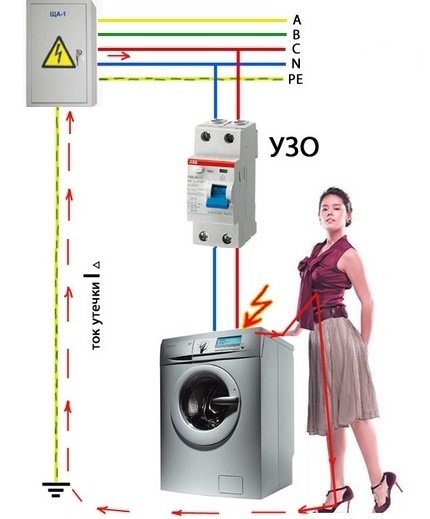
Wiring Type Selection
In old buildings built several decades ago, wires with aluminum conductors were mainly used. They are not suitable for connecting modern powerful equipment.
The washing machine may only be connected via a three-core cable with a copper core.
You may also need information on what types of wires are used to install electrical networks in an apartment, reviewed here.
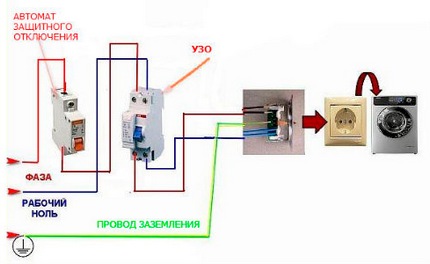
According to Clause 7.1.40 of the current EMP in rooms with high humidity, wiring is recommended to be closed.
To do this, the cable coming from the distribution panel is placed in the gate selected in the wall so that it is hidden and does not even partially come to the surface.
This measure protects the cable from direct contact with water, which is known for its excellent conductive qualities.
For the same reason, when laying in a channel hollowed out in wood, for example, it is not allowed to place an electric wire in a metal hose or in the cavity of a steel pipe.
The wire cannot be fixed with metal brackets devoid of rubber gaskets. The mounting brackets themselves must have a corrosion-resistant coating.
Cable cross section
In order for the wiring to withstand high loads from a powerful household unit, it should be correctly calculated cable section.
It is determined by the same principle as when installing any other electrical equipment, taking into account the estimated load. The power of the washing machine is indicated in the instructions attached to it.

For laying the power line use only a defective integral wire. All joints are carefully wrapped with electrical insulating adhesive tape.
The presence of junction boxes in the bathroom, inside the hollow body of which the cables of connected devices are connected according to the scheme, is not allowed. Junction boxes are always placed outside the bathroom.
The procedure for determining the cross-section of the cable:
- Find out the power of the connected electrical appliance. In most cases, it does not exceed 3 kW.
- In accordance with the reference tables, the cable section is selected.
When connected outlet block determine the total power of the devices “powered” from them, and then, guided by the same reference tables, determine the permissible cable cross-section.
Even if the machine consumes less energy, experienced craftsmen recommend making a reserve of power. After all, it is possible that over time a morally obsolete unit can be replaced with more powerful new equipment.

Only copper wire is recommended for connection. Compared to the aluminum "fellow", it is preferable in that it has the best conductive properties.
The copper wire is able to withstand a high voltage with a smaller cross section: 1 mm section 2 kW load. And therefore, the wire laid in the strobe will take up half as much. In addition, it is resistant to oxidation and, with the assurance of electricians, has a service life of over 30 years.
Power RCD and machine
A cable leading a separate line to the bathroom is connected to the in-house distribution panel via an emergency shutdown device (RCD).

The leakage current of the line protector when quick protection is needed should be 10 mA.This is due to the fact that the bathroom is characterized by increased humidity, and therefore the room is one of the rooms of increased danger.
The person feels the irritating effect of alternating current already at a value of 5-7 mA.
If the bathroom is “powered” by a group line, the maximum leakage current for connecting the wiring should be 30 mA. Such devices are cheaper than 10 mA, but they do not work as fast.

For the installation of private houses and apartments, models most often used are combined with an automatic machine for protecting wiring - differential switches.
You may also have information about differences between RCDs from the difavtomatconsidered in our other article.
Modular devices provide protection on three "fronts": from overload of the power supply network, from exceeding the permissible value of current leakage and from a short circuit on the line.
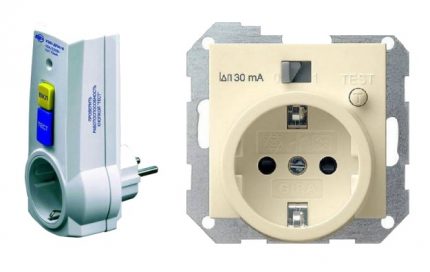
If there is no stationary RCD in the apartment in the distribution panel, a portable type RCD is used. They are connected to an existing outlet, and then electrical equipment is connected.
But the RCD itself is not a full protection. To protect the wiring and the unit itself from short circuit, a separate circuit breaker is installed.

Traditionally use a 16A machine. In any case, the rated current of the RCD must be one category higher than the rated current of the input automatic machine.
Mount Point Locations
When choosing the location of the connection point, the key factor is not so much the proximity to the “powered” household appliance, but rather the distance from moisture sources and the height relative to the floor level. In the joint bathroom there are only 1-2 such safe places.
When choosing a location, the connection points are guided by the following parameters:
- All electrical outlets for connecting household appliances are placed at a height of not less than 60 cm from the floor. This requirement is explained by the fact that in the case of a breakthrough in pipes and heavy leaks, minimize contact with electricity, which can provoke an emergency.
- Regarding objects that are sources of water or splashes, sockets are placed with a distance of 60 cm. This solution also reduces the risk of moisture entering the connected device, making its operation safer.
When determining the height of the installation of outlets should be guided by the principle of "the higher, the better."
High-quality repairs in the apartment are not a guarantee that at a fine moment the stream from the common pipe will not flood, or the “waterfall” will not spill from the neighbors living on the floor above. Therefore, some experts recommend equipping power sockets at a height of 130 cm from the floor.

When designing wiring in the bathroom should be guided clause 7.1.47 of the current EMP.
According to him, the room is divided into 4 zones:
- Red zone - referred to as zero, located within the washbasin, bathtub and in the area of the shower. No sockets can be placed in it.
- First zone - directly above or below the shower, bath bowl, capturing an area with a radius of 0.6 meters. It allows the installation of equipment necessary for the operation of plumbing with a capacity of 12 V. There should not be any sockets in this zone.
- Yellow or second zone - placed after 60 cm, water heating devices are connected in it. Sockets cannot be installed either.
- Green or third zone - from the zone “2” it is located at a distance of 2.4 m. All IPX4 sockets and household units, “powered” from the network, connected through an RCD with a grounding contact, are located in it.
Outlets are not allowed to be placed on cold walls, on the surface of which condensate accumulates.

Sockets used to connect the washing machine in the bathroom must meet the following requirements:
- Enclosures waterproof sockets provide protective covers to prevent the ingress of moisture.
- The internal part of the devices is insulated with dense rubber gaskets, which minimize the likelihood of sparks between the contacts.
The level of protection of waterproof sockets is determined by the marking "IP". The higher the digital score, the more reliable the device. So, the “IPX1” class models protect only from small splashes, and “IPX4” - they are not afraid even of direct water jets.
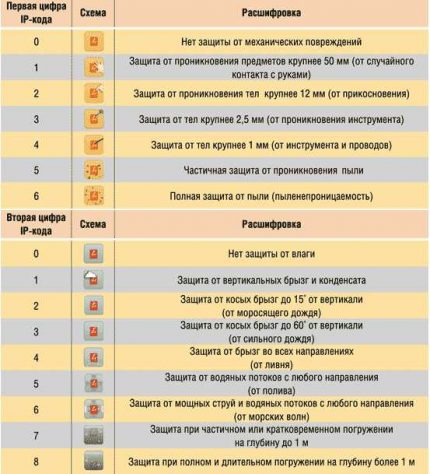
The subtleties of connecting the outlet for the washing machine
When planning to connect a washing machine in the bathroom of a house that is over 20 years old, carefully inspect the wiring first. Most likely, there are aluminum wires.
They can not be used to connect powerful appliances, which include a washing machine. Since the conductivity of an aluminum core is almost two times lower than that of copper, and when oxides appear on the surface, the value decreases even more.
To lay the power line for connecting the washing machine, you will need a cable with aluminum conductors thicker than with copper, which will not affect the total cost in the best way. Quality wire connections It must be impeccable to prevent overheating.
When operating the power point, you will have to regularly check and tighten the screw clamps.

Be prepared for the fact that replacing obsolete aluminum wiring with a copper analog will cost a pretty penny. But the safety of households and the normal operation of equipment directly depend on it.
Some owners in the bathroom install one connection point for all electrical appliances. To do this, lay a wire with a cross section of 2.5 mm, to which the outlet unit used to “power” not only the washing machine, but also other electrical appliances is connected in a loop manner.
Experienced craftsmen do not recommend this, but they still advise laying a separate wire to the washing machine.
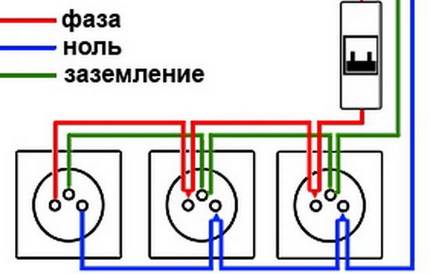
When installing multiple outlets, it is advisable to arrange the connection points as compactly as possible. You can also bring the underfloor heating control panel to the outlet block.
As a protective element, you can install a switch for the outlet itself. But it should be considered only as a safety option, serving as an addition to the general security system.
Mounting Point Technology
At the time of installation of the outlet, an automatic machine or RCD should already be in the electrical panel, and the wire itself is brought to the bathroom.
Before proceeding with the installation of the connection point, make sure that the wire is not energized by touching the cable ends that are cleaned from the braid with an indicator screwdriver
Step # 1 - laying the cable and installing the socket
To perform hidden wiring in the cavity of the wall using a punch, a strob is made. It is laid along the smallest path under the ceiling parallel to the floor surface.
To the outlet, the line is lowered strictly down perpendicularly. The wiring is fixed in the strobes using dowel clamps.
To outline the location of the outlet, a device case is applied to the center of the laid strip. Using a marker make marks for drilling holes. Having outlined the location of the outlet, use a puncher equipped with a D 68 mm crown to make a hole in the wall.
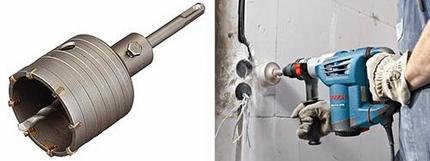
The walls of the hole made are cleaned of dust and fragmented wall elements. In the prepared seat mount the socket.
The selection of the wall socket depends on the type of wall. For installation in concrete, mounting blocks are used without any fixing elements. For drywall - plastic cups equipped with pressure plates for fixation from the back of the sheet. Read more about mounting technology can be read in another article.
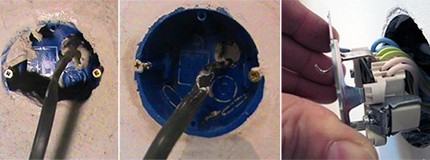
In the installed socket, the terminal block will be hidden for connections to the electrical wiring hidden in the wall.
Step # 2 - connecting the terminal block
Decorative elements are removed from the outlet housing, leaving only the terminal block. At the terminals, the fixing bolts are loosened, with the help of which the bare ends of the lead wires will be fixed.
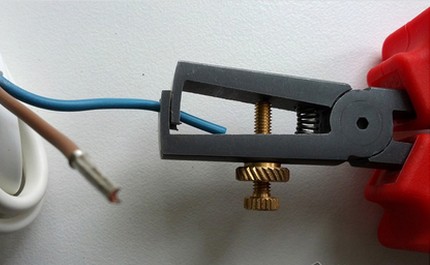
For ease of connection, the insulation of the lead wires is made in different colors. The ground wire is painted in a green-yellow sheath, the phase wire is represented by a red or brown sheath, and the zero wire is in blue or blue insulation.
The ends of the wires removed from the plastic “glass” are brought to the contacts and inserted into the terminals. The phase and neutral wires are connected to current-carrying terminals: phase on the right, neutral on the left. The ground conductor is connected to the terminal indicated by the abbreviation "PE".
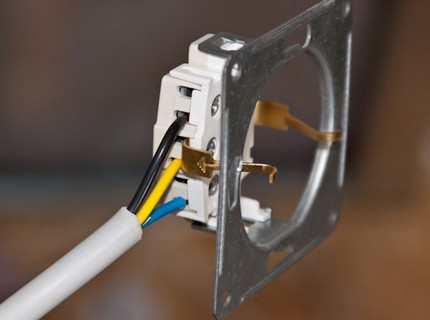
In no case do not connect “zero” to the grounding terminal. Otherwise, if the working “zero” burns out, the reverse “phase” will break through the shield on the body of the machine connected to the network.
The socket housing with the connected contacts is fixed to the socket by screws or spacer tabs. After fixing the unit, check the quality of the connection of the contacts and the tightening of the bolts on the terminal blocks.
At the final stage, a decorative cover is installed.
Conclusions and useful video on the topic
Tips for installing connection points in the bathroom:
How to lay the wire for the washing machine:
Works related to electrical wiring belong to the category of increased danger. And they should be carried out with utmost care.
If you are not able to correctly assess the situation and are not confident in your own abilities, do not experiment. The solution to this difficult task is best entrusted to a professional electrician.
Did you do the self-installation of the outlet for connecting the washer? Tell us what turned out to be the most difficult for you and how the connection point is functioning now.
Perhaps you have questions after studying our instructions? Feel free to ask us by filling out the comment form under this article.

 Installation of sockets in the bathroom: safety standards + installation instruction
Installation of sockets in the bathroom: safety standards + installation instruction  TV outlet: how to install an outlet for a TV
TV outlet: how to install an outlet for a TV 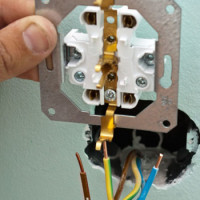 How to make two from one outlet and how to properly conduct an outlet from an outlet
How to make two from one outlet and how to properly conduct an outlet from an outlet 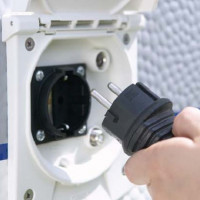 Moisture-proof sockets: an overview of the possibilities, where to use and how to choose
Moisture-proof sockets: an overview of the possibilities, where to use and how to choose 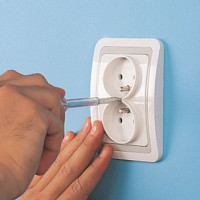 How to connect a double outlet: installing a double outlet in one socket
How to connect a double outlet: installing a double outlet in one socket  How to choose sockets and switches: an overview of the best brands in today's market
How to choose sockets and switches: an overview of the best brands in today's market  How much does it cost to connect gas to a private house: the price of organizing gas supply
How much does it cost to connect gas to a private house: the price of organizing gas supply  The best washing machines with dryer: model rating and customer tips
The best washing machines with dryer: model rating and customer tips  What is the color temperature of light and the nuances of choosing the temperature of the lamps to suit your needs
What is the color temperature of light and the nuances of choosing the temperature of the lamps to suit your needs  Replacement of a geyser in an apartment: replacement paperwork + basic norms and requirements
Replacement of a geyser in an apartment: replacement paperwork + basic norms and requirements
In general, almost everything comes down not to installing the outlet itself, but to organizing the correct dedicated wiring. Perhaps that is why now in many even new homes, washing machines are installed immediately in the kitchen, and not in the bathroom. Of course, there is also water there and precautions must be observed, but the kitchen is a room with much less humidity.
Still, mostly washing machines are placed in the kitchen due to the presence of more free space there. If there is no problem with a place in the bathroom, then it is much more convenient to install it there. With a competent approach to connecting (including sockets), higher humidity is not important.
During the repair of the bathroom, I installed a moisture-proof outlet. It was already grounded, closed with a lid on top. The installation did not cause any problems; it did not require much effort. The socket pleased, as I accidentally had to check for leaks - my son sprayed from a water gun. Not a single drop fell inside. The washing machine works fine.
I do not quite understand about the RCD and the additional automatic shutdown. It turns out that simply an RCD will not cut off the supply of electricity at the right time? Or am I misunderstanding something? For example, many powerful devices are already equipped with an RCD on a wire with a plug. When electricity breaks, the Uzo trips and turns off the device. Do others not work on the same principle?
Good afternoon, Valentine. The circuit breaker trips in case of short circuits to the ground, neutral conductor, and other metal short-circuit options. For example, the insulation of the washing machine punched on the case, which is grounded, as PUE require - the machine will work.
Differential RCD will disconnect the washing machine, which is not grounded. For example, the phase closed on the case, and then there was no place for the current to flow - the legs of the machine were plastic, current began to flow through the neutral wire, but not enough for the circuit breaker to trip. You go to the washing machine, touch the case and the RCD “instantly” turns off the electric line going to the machine. You can read the details in the section "RCD and machines».
Hello! I purchased a WLG Bosch 20160 washing machine, 2.3 kW. Since the bathroom is very small in size, I placed the car in the kitchen. For her, I installed the Etude outlet (manufacturer Schneider Electric, rated current 16A, rated voltage 220V, also in the apartment there are 4 single-pole circuit breakers 16A and one two-pole 25A). Please specify if I can use such an outlet, the car has not yet been plugged into the network.
And another question: in the kitchen there is a Hansa gas-electric stove with electric oven (total power of 2 kW - both heating elements). Is it possible to replace a single socket in the same socket with a double socket of the same manufacturer with similar characteristics and use the devices alternately without removing the plugs from the socket.
Thank!
Good day, Sergey. The listing of installed circuit breakers does not give an idea of the power scheme of your apartment.
If the 25-amp automatic machine is mounted on the input, then it will withstand the washing machine (it consumes 10.5 A), but while working with the electric oven (it consumes 9A), it can be knocked out by the starting current of the machine (I will not absolutely say).
Surely a 16-amp automatic machine is on the outlet group - it will be knocked out of these two powerful power consumers. 16-amp sockets themselves will not suffer. The bearing capacity of the wire going to the dual outlet must be checked.
In general, the issue of electricity supply to apartments is covered in detail by “SP 256.1325800.2016” (attached a screenshot of the necessary section to the answer). Do not invent, follow the Rules and read the articles in the “wiring installation" on our website.